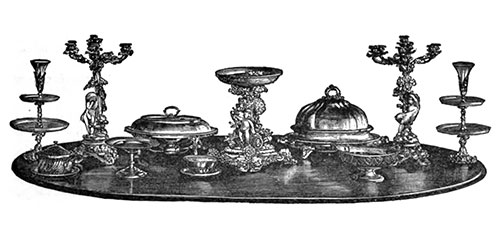Bill of Fare - Dinner Menu - 1916

The Dinner Menu or Bill of Fare
Should the menu be intended for dinner including ladies, it must be composed of light, fancy dishes with a pretty dessert; if, on the contrary, it is intended for gentlemen only, then it must be shorter and more substantial.
If the dinner is given in honor of any distinguished foreign guest, then a place must be allowed on the menu to include a dish or several dishes of his nationality; avoid repeating the same names in the same menu.
Let the sauces be of different colors, one following the other. Also vary the color of the meats as far as possible, from one course to the other.
Offer on the menus all foods in their respective seasons, and let the early products be of the finest quality (consult a general market list to find the seasonable produce), and only use preserved articles when no others can be obtained.
If the menus are handwritten, they must be very legible. Menus are indispensable for service à l’Américaine; there should be one for each guest, for as no dish served from the kitchen appears on the table, everyone must be informed beforehand of what the dinner is composed, and those dishes that are to follow each other.
Menus must be both simple and elegant, and of a size to allow them to be easily placed in the pocket without folding, as it is the general desire to keep the bill of fare of a dinner at which one has assisted.
A few important observations necessary to bills of fare and their classification are here given:
SOUPS: One clear and one thick soup should be selected but if only one is needed, give the preference to the clear soup.
HORS-D'OEUVRE, SIDE OR LIGHT DISHES: Hot hors-d’œuvre are, generally, timbales, croustades, cromesquis, palmettes, mousselines, bouchées, cannelons, cassolettes, rissoles, etc. With the same course serve cold side dishes, such as olives, radishes, canapés, caviar, pickled tunny, anchovies, etc.
In the French service, the fish and the solid joints come under the head of relevés or removes. In the American and English service, first comes the fish, then the removes.
FISH: If the fish be boiled or braised, add potatoes to the menu; if broiled or sautéed, some cucumber salad; and, if fried, serve plain or with a light sauce.
REMOVES OR RELEVÉS: The relevés or solid joints are composed of saddles, either of veal, mutton, lamb, venison and antelope, or else beef tenderloins or middle short loins. Turkey, goose, capon, pullets, ducks, etc.,
may be served, accompanied by one or two vegetables.
ENTREES: Place on the bill of fare first the heaviest entrée and conclude with the lightest; they must be previously cut up to avoid carving. No fish figures in the American service as an entrée but terrapin or crabs may be allowed; also, lobsters, shrimps, frogs, croquettes, etc.
Each entrée should be accompanied by a vegetable, served separately, except when it is one of those described above, such as terrapin, etc.
PUNCH OR SHERBETS: A punch or sherbet is always served after the entrées and before the roast; do not make an extra heading on the menu for these, only placing them on a line by themselves, for instance: Roman punch or American sherbet.
ROASTS: Roasts are served after the sherbet; a game roast is usually preferred, but poultry, either truffled or not, may be substituted: such as turkey, capon, pullet, duck, guinea-fowl, squabs, etc.; also roasted butcher's meat, but game is usually considered to be more choice.
COLD DISHES: Cold dishes come after the roast, and before the hot dessert; they are served with green salads; terrines of foies-gras and boned turkey are also served as a second roast. (In the French service, these cold dishes are classified as the last entrée.)
HOT SWEET DISHES OR ENTREMETS: These appear after the roast; they are composed of puddings, crusts, fried creams, fritters, pancakes, borders, omelets, and soufflés, and form a separate course by themselves.
COLD SWEET DISHES OR ENTREMETS: The cold sweet entremets comes after the hot and is composed of Jellies, bavarois, creams, blanc-manges, macédoines, charlottes and large cakes, and form another course.
DESSERT: After the cold entremets comes the dessert, composed of cheese, fresh fruits, preserved fruits, cakes, Jams, dried fruits, candied fruits, bonbons, mottoes, papillotes, victorias, pyramids, frozen puddings, plombières, ices, ice cream and small fancy cakes, then the coffee and cordials.
